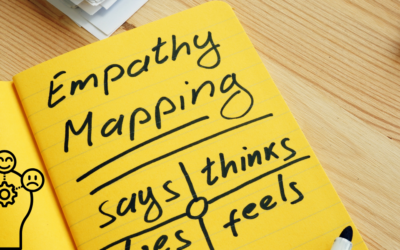Here’s a quick question: When was the last time you genuinely felt seen by a brand?
Imagine landing on a website and instantly feeling that “wow” factor. Everything from the layout and flow to the tiny nudges feels effortless. You don’t have to ask for help. You’re not confused. You just… vibe with the experience.
That’s the invisible magic of customer experience journey mapping.
At its core, a customer experience journey map is a visual representation of your customer’s entire relationship with your brand. From the first Instagram ad or Twitter post to the moment they become brand advocates, it showcases the whole experience.
But let’s be clear, it’s not just about what they click. It’s about how they feel while doing it. Frustrated, excited, unsure, or relieved? Mapping this out helps you respond with clarity at every touchpoint.
Customer Experience Journey Mapping: Your Brand’s Secret Weapon to Win Hearts
In today’s hyper-digital world, where attention spans are shorter than a Reel, customer experience journey mapping services aren’t a luxury they’re a necessity.
Why Customer Journey Mapping Matters
Let’s be real, customers are spoilt for choice.
They expect everything to work seamlessly: your website, your app, your WhatsApp responses, your emails, and even your Instagram DMs.
One broken moment and… poof, they’re gone.
That’s why customer experience journey mapping is a game-changer.
It helps brands:
- Understand the actual user journey
- Identify and resolve friction points early
- Create those little moments that make customers go, “This brand gets me.”
Whether you’re building a skincare startup or scaling a SaaS platform, journey mapping aligns your team around one shared vision, understanding and delighting your customer.
What Is a Customer Experience Journey Map?
Let’s break it down.
A customer experience journey map (also called a consumer journey map) is not a robotic series of actions like:
Click ad → Visit site → Add to cart.
A real journey map goes deeper. It explores the customer’s needs, frustrations, hesitations, and emotions at every interaction.
Think of it like telling a story, from your customer’s perspective. Not just what happens, but how it feels when it happens. And if you’re a tech brand, even one confusing UI can break the flow. That one misstep can shift the entire experience.
CX Journey Map vs. Traditional Journey Map: The Real Difference
Time for a quick comparison, because they’re not the same.
A traditional journey map is checklist-driven:
Visit → Browse → Buy → Exit.
It captures actions, but not emotions.
On the other hand, a CX journey map (or user journey map) includes:
- What the customer is thinking and feeling
- Trust and hesitation during payment
- Anxiety while waiting for delivery
- Frustration when seeking support
Traditional journey maps = business-focused
CX journey maps = customer-focused
And in today’s experience-driven economy, that emotional layer is what makes the difference.
The Core Goals of Customer Experience Journey Mapping
Here’s what we aim for when using customer experience journey mapping services:
- Empathy
Understand what drives and frustrates users—not just what they’re doing, but why they’re doing it. - Optimization
Remove unnecessary steps, reduce friction, and streamline the process. - Personalization
Deliver content and experiences tailored to different user personas, not a one-size-fits-all approach.
Done right, customer journey mapping removes the guesswork and replaces it with insight.
Key Elements of a Customer Experience Journey Map
Creating a strong journey map starts with the right ingredients:
- Customer Personas
These represent real user types based on data and behavior. They bring specificity to your mapping process. - Stages of the Journey
Awareness → Consideration → Purchase → Onboarding → Use → Support → Loyalty → Advocacy - Customer Goals & Motivations
What are users trying to accomplish at each stage? Are they just browsing, or ready to commit? - Pain Points
Identify what causes friction, clunky navigation, poor support, and unclear messaging. - Touchpoints
Every interaction matters: your website, mobile app, email, ads, in-store visits, and social DMs. - Emotional States
Excited? Hesitant? Confused? These states shape how your customer remembers the experience. - Moments of Truth
Crucial decision points, like delivery expectations or return policies, can make or break trust. - Internal Ownership
Assign accountability across departments, Marketing, UX, Product, and Support, so nothing gets overlooked.
Real-World Example: Why This Works
Let’s say an online bookstore notices a spike in cart abandonments.
By mapping the customer journey, the team discovers that their checkout page is complicated and lacks trust signals. They redesign it, add live chat for support, and improve messaging around delivery and returns.
Result? Purchase completions increase by 20%.
That’s how CX journey mapping turns into real ROI.
How to Create a Customer Journey Map: Step-by-Step
Ready to map? Here’s how we guide brands through it:
- Set Clear Goals
Start with a specific outcome, improved onboarding, reduced churn, and more signups. - Collect Customer Data
Don’t assume- use surveys, user interviews, analytics, and session recordings. - Create Personas
Define clear user types to avoid generalising everyone’s journey. - Map Journey Stages
Detail each interaction from first touch to loyalty or churn. - Identify Touchpoints
Include all customer-brand interactions, both online and offline. - Document Thoughts, Feelings, Actions
What is the user doing, thinking, and feeling at each step? - Highlight Pain Points
Look for drops, frustrations, or friction zones these are gold. - Validate Your Map
Test it with users and cross-functional teams to ensure accuracy. - Collaborate Internally
CX isn’t one department’s job. Everyone should own the experience. - Keep It Updated
Revisit the map after every major release or marketing campaign.
Use Case: SaaS Product Activation
A SaaS platform notices users sign up but never complete onboarding.
We conduct customer experience journey mapping, which reveals that new users are overwhelmed by feature overload. There’s no clear direction.
The fix? A simplified onboarding flow with tooltips, a “Start Here” guide, and a personal welcome message.
The result? Activation rates double.
That’s the power of mapping the experience, not just building features, but building for real humans.
Journey Mapping vs. Other Experience Mapping Tools
Let’s quickly compare:
| Tool | Focus Area | Best Use Case |
| Journey Map | End-to-end experience | Improving checkout flows |
| Experience Map | Overall context of life | Mapping holistic life experiences |
| Service Blueprint | Back-end + front-end | Restaurant or call center workflows |
| User Story Map | Product features | Designing app or SaaS functionality |
Each has its place. But for those serious about customer-centric growth, journey mapping is the go-to framework.
Best Tools for Customer Experience Journey Mapping
Here are some tools our team recommends:
- UXPressia – Built for CX, great persona templates
- Smaply – Comprehensive and easy to collaborate on
- Miro – Great for whiteboard-style mapping, especially remotely
- TheyDo – Ideal for end-to-end journey mapping with strong alignment to business processes
- Lucidchart – Fantastic for process visuals
- Figma – Great for custom-designed and interactive maps
Most offer free trials. Find what fits your team’s rhythm.
Advanced Tips for Better Mapping
To take your journey maps to the next level:
- Track emotions, not just steps
- Rely on data, not assumptions
- Bring in cross-functional perspectives
- Make it actionable
- Review and refresh the map regularly
How to Present Journey Maps Internally
Now that you’ve built your journey map, here’s how to make it resonate:
- Tell a story – Show the real customer struggle
- Visualise it – Diagrams > Data dumps
- Share widely – Use it in standups, strategy meetings, and planning sessions
- Tie it to goals – Map insights to business outcomes like churn, NPS, or conversions
- Keep it visible – It should be a living, evolving artifact, not a static doc
Start Mapping Your Customer Experience Today
Still wondering why customers abandon halfway or never return?
The answer’s probably hidden in the customer experience journey.
The best part? You don’t need expensive software or a huge team to start. Just a clear goal, some honest feedback from users, and a good old-fashioned map.
At UX Prosperar, we help brands uncover blind spots, elevate moments of delight, and connect emotionally with their users through tailored customer experience journey mapping services.
Ready to craft unforgettable customer experiences? Connect with us today to explore our expert customer journey mapping services.
Frequently Asked Questions
How often should we update our customer journey map?
Every six months, or after major product, service, or marketing changes.
Can small businesses benefit from CX journey mapping?
Absolutely. In fact, smaller brands often move faster and adapt better to insights.
What’s the most common mistake brands make?
Mapping from the company’s perspective instead of the customer’s. That’s where most efforts fall flat.
Do we need fancy tools to start?
Not at all. A pen and paper, Post-it notes, or a Miro board is enough to begin.
5. What’s the biggest mistake teams make with UX research?
- Bad approach: “We did user interviews last year.”
- Good approach: “We track how pandemic WFH habits changed our app usage monthly.”
- Example: Duolingo’s owl isn’t annoying by accident—they constantly research what guilt-trips actually work.







